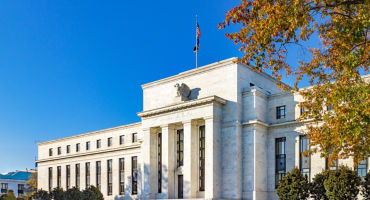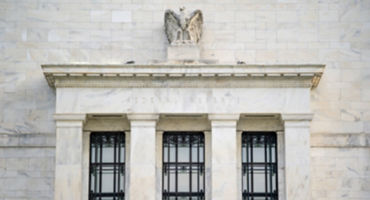- Fixed Income Portfolio Manager
Skip to main content
- Funds
- Insights
- Capabilities
- About Us
- My Account
The views expressed are those of the author at the time of writing. Other teams may hold different views and make different investment decisions. The value of your investment may become worth more or less than at the time of original investment. While any third-party data used is considered reliable, its accuracy is not guaranteed. For professional, institutional, or accredited investors only.
Following four consecutive 75 basis-points (bps) increases to its policy rate, the Federal Open Market Committee (FOMC) finally slowed the pace of its rate-raising campaign, with a 50 bps hike at its December meeting — a move that had been widely anticipated by most observers.
Despite the smaller rate increase, the FOMC signaled that monetary policy might need to be even more restrictive in 2023 than it had projected this past September, with its policy rate likely going higher than what’s recently been reflected in market prices. Although the November inflation print showed further deceleration, US Federal Reserve (Fed) Chair Jerome Powell suggested that the FOMC will need to see “substantially” more evidence that inflation is continuing to drift lower — which could take several months or more of encouraging data — before the Fed would be willing to pause its rate-hiking cycle.
The annual US headline inflation rate, as measured by the Consumer Price Index (CPI), moderated to 7.1% year over year in November 2022 — its lowest level of the year — helped by a sharp decline in the energy components of the index. Core inflation also fell more than expected, to 6.0% year over year.
A significant drop in core goods prices accounted for the bulk of the easing inflation, while core services prices have proven “stickier” due to the shelter component remaining quite elevated relative to history. However, most of the leading indicators I track suggest that house prices will come down over the next six to 12 months. Even so, my base case right now is for US inflation to end 2023 above the Fed’s target, which would make it exceedingly difficult for the Fed to justify the interest-rate cuts the market has been pricing in.
I suspect the Fed will lift its policy rate to a terminal level of around 5% by the first quarter of 2023 and then go “on hold” to ensure that monetary policy remains restrictive enough to keep pushing inflation lower.
Thus far, the labor market has been quite resilient in the face of Fed policy tightening, but that will need to change before the Fed can even consider cutting rates. Unfortunately, that probably means the US unemployment rate will need to rise by more than the Fed is currently forecasting in order to achieve enough demand destruction to bring inflation down sufficiently.
As of this writing, I maintain a bias for the US Treasury yield curve to continue to flatten from here. Most fixed income investors are well aware of the heightened risk of an economic recession next year, with many proclaiming it would be the most well-telegraphed US recession of all time. If the Fed prematurely waves the “all-clear” flag and begins to cut rates with inflation still perched above its target, inflation could quickly reaccelerate, damaging the Fed’s inflation-fighting credibility in the process.
Bottom line: I’d say the Fed has a tough and unenviable task ahead of it.
Expert

Chart in Focus: Is the Fed rate cut positive for risk?
Continue readingThe Fed architecture under scrutiny: What are the investment implications?
Continue readingTwilight zone: how to interpret today’s uncertain macro picture
Continue readingURL References
Related Insights

FOMC: Easing into uncertainty
Fixed Income Portfolio Manager Jeremy Forster profiles the Fed's December rate cut, labor market trends, inflation pressures, and the role of anticipated changes to FOMC leaders in 2026.

Chart in Focus: Is the Fed rate cut positive for risk?
In this edition of Chart in Focus, we examine how the Fed’s long-awaited interest rate cut may influence risk assets.

The Fed architecture under scrutiny: What are the investment implications?
Macro Strategist Juhi Dhawan looks at how changes in the Federal Reserve's personnel and decision making could impact policy, the US dollar, and financial markets.

FOMC: Cushioning the US labor market
Fixed Income Portfolio Manager Jeremy Forster analyzes the Fed's decision to cut interest rates at the September FOMC meeting.

Twilight zone: how to interpret today’s uncertain macro picture
Macro Strategist John Butler and Investment Director Marco Giordano explore how to interpret today’s uncertain macroeconomic picture and its key implications.

Rethinking the Fed’s dual mandate
Is it time for a fresh perspective on the dual mandate? Fixed Income Portfolio Manager Brij Khurana explores the potential benefits of reorienting monetary policy toward maximizing productivity.

Stagflation watch: Thoughts on tariffs, inflation, and Fed policy
US Macro Strategist Juhi Dhawan considers signs the US economy may be moving toward a toxic mix of slowing growth and rising inflation, creating challenges for the Fed and investors.

Severance: The split between the economy and the markets
While markets have bounced back since Liberation Day, policy changes and macro data bear watching. Heading into the second half of 2025, we're focused on relative opportunities across asset classes created by disconnects and divides between markets and economies.

Oh baby, baby, it’s a wild world
Just one quarter into the year, many policy and economic assumptions have been turned on their head. What does it all mean for equity, bond, and commodity markets around the world? Members of our Investment Strategy & Solutions Group offer their outlook.

Fed delivers rate cut, but hawkish 2025 guidance sends yields up
Fixed Income Analyst Caroline Casavant examines the outcome of the December 18 Federal Open Market Committee meeting and the implications for rates, inflation, and real growth.

Going their separate ways: Capitalizing on bond divergence
Our fixed income experts discuss how to position portfolios for a world of uncertainty and divergence, exploring key themes and evolving bond opportunities for 2025.
URL References
Related Insights